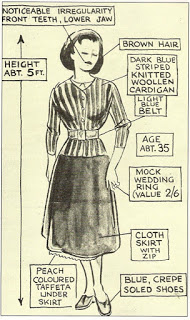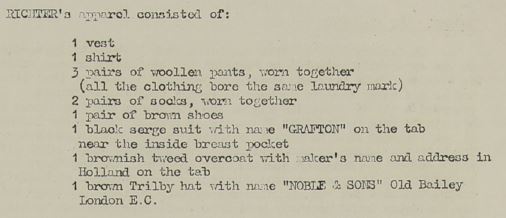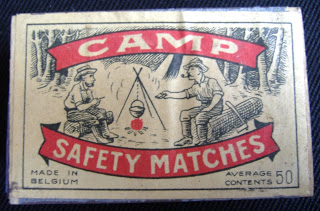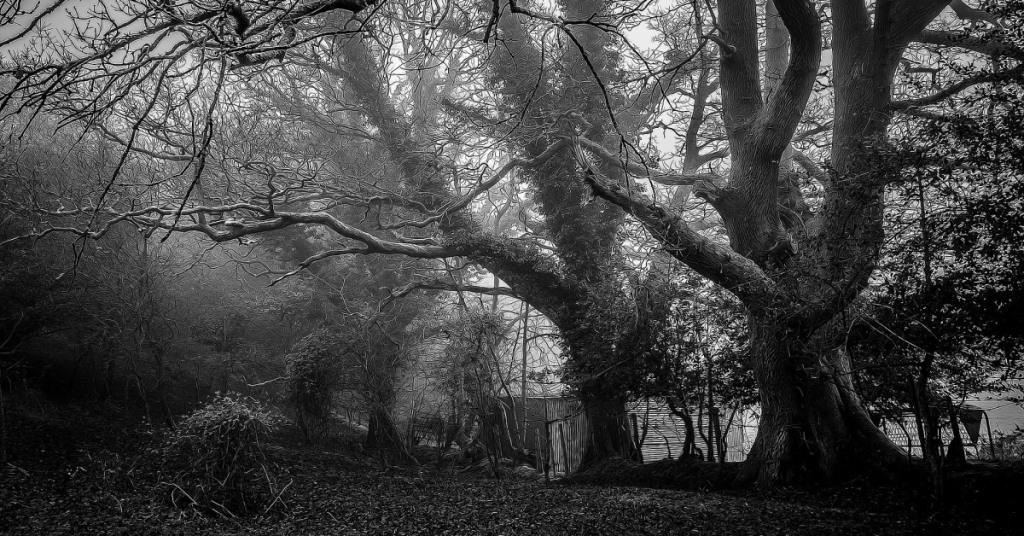In researching the Bella in the Wych Elm case, I’ve noticed that several commentators make much of the fact that the tags had been removed from her clothing. Some have suggested that her clothing may have been “seconds” from a market, while others have gone so far as to say that the absence of tags lends weight to the theory that she was a German spy. After all, spies cut the tags out of their clothing as part of their under-cover modus operandi. Didn’t they? It’s a nice theory, but does it really hold up in the case of Second World War espionage in the United Kingdom?
What many fail to realize is that most of the spies thrown at Britain in late 1940 and early 1941 were poorly trained and poorly prepared. Even MI5 was perplexed that the oh-so-organized Germans could be sending over agents of such poor calibre. But Germany was desperate… and the agents who came over were often sent at bayonet point, so-to-speak. Leaving aside all of the espionage equipment, identity papers and ration cards, which had their own potential flaws that could expose an agent, let’s take a look at the personal items of a couple of agents – Josef Jakobs and Karel Richter.

The Clothing of Josef Jakobs
Josef Jakobs landed near Ramsey on the evening of 31 January, 1941. He had broken his ankle during his exit from the aircraft and lay in agony all night. Upon being discovered the following morning by a couple of farm workers, Josef was taken to the Ramsey Police Station where his possessions were itemized. Detective Sergeant Thomas Olive Mills of the Huntingdonshire Constabulary noted in his report:
I subjected the man’s clothing to a thorough search and appended hereto is a list of his property – it is significant to note that all his clothing (which were of continental cut), his property, etc., all bore tabs or markings denoting they were made either in Germany proper or in German occupied country. (KV 2/24 – 20b)


Not only did Josef’s clothing bear the clothing tags and markings of Germany and/or German occupied countries, his clothing itself was a dead giveaway as it was of a continental cut. The itemized list of his possessions had a few other key items:
- Spectacles – case marked Optiker Ruhnke (German)
- Two packets of Orange Fin Jonker product chocolate. “Lekkere chocolate van Cacaofabriek De Jonker Zaandijk” (Dutch)
- Leather cigarette case marked Zeka Wettig Gedder (Dutch)
- Dictionary – Metoula Sprachfuhrer (German)
- Tie – Hemdenplatz – Berlin (German)
- Trilby Hat – Helium (unknown)
- Black shoes – Medicus, Dresden (German)
Josef was equipped with German spectacles, Dutch chocolate, a Dutch cigarette case and German shoes – all clearly marked. Not so incognito.
The Clothing of Karel Richter
As for Karel Richter, he didn’t fare much better. Richter landed via parachute in May 1941 and was swiftly captured. He wore a black serge suit with the name “Grafton” on the tab near the inside breast pocket. On top of that he wore a brownish tweed overcoat with the maker’s name and an address in Holland on the tab. His brown trilby hat, surprisingly, was marked “Noble & Sons Old Bailey, London E.C.” Richter’s career as a merchant seaman prior to the war may have provided him with access to some American and/or British clothing.

Clearly, it would have been best if the spies had been dressed in clothing sourced from Britain. But the German Abwehr had limited access to such articles. Given the large number of German-Jewish, Dutch and Belgian refugees in England, it would not have been remarkable for a legitimate individual to have such items of clothing. It might even have been more suspicious if all the clothing tags had been removed from items with a “continental cut”. Better to leave the tags in and hope that the poor wearer would pass as a refugee.
While the German Abwehr appeared to be sending quite incompetent and poorly prepared agents to England, on the other side of the Atlantic, they were doing faring slightly better. Two German agents were landed on the coast of Canada in 1942. Both spies were well-prepared, well-equipped and had spent time in Canada before the war. They were both familiar with the country, the language and the customs. Perfect spy material.
Two German Spies sent to Canada
Werner Alfred Waldemar von Janowski, was landed on the coast of Quebec near New Carlisle and captured the next morning. Janowski stopped in a hotel while waiting for a train heading in the direction of Montreal. The eagle-eyed son of the hotel proprietor noticed that the man’s clothing was a little odd.
“His shoes were quite different from anything I had ever seen. They were a brown-colored summer type with a thick, light-colored sole, which appeared to be rubber, and had an odd-looking welt around the toes. His dark gabardine topcoat was not quite like the Canadian style. It had patch pockets instead of the slip-in type.” (Earle Annett Jr)

On top of that, the young man noticed that Janowski had a packet of Belgian matches which were lacking the excise label. Several tiny slip-ups and yet enough arouse the suspicions of the locals and quickly end the career of would-be-spy Janowski.
The second spy, Alfred Langbein, landed on the rugged coast of the Bay of Fundy in May 1942. He managed to escape detection for over two years before turning himself in to the police. During his first week in Canada, he bought a new hat, visited a barbershop to “rid himself of his distinctive German haircut” (as his German spymaster had suggested) and bought several clothing items at a second-hand clothing shop.
Conclusion
The perfect spy would be equipped with local clothing, speak the language impeccably and be familiar with the local culture, customs and currency…. but the German spies sent to Britain were not perfect spies. Their spy masters were new to the espionage game and mistakes were made. Poor planning and desperation combined to send men off on suicide missions to a country where inhabitants were on high alert for anything out of the ordinary. Clothing tags or no clothing tags, there was more than enough other indicators to give away the enemy agents who came to Britain.
Sources
National Archives – Security Service files on Josef Jakobs – KV 2/24
National Archives – Security Service files on Karel Richter – KV 2/31
Beeby, Dean – Cargo of Lies: The True Story of a Nazi Double Agent in Canada – 1996.
